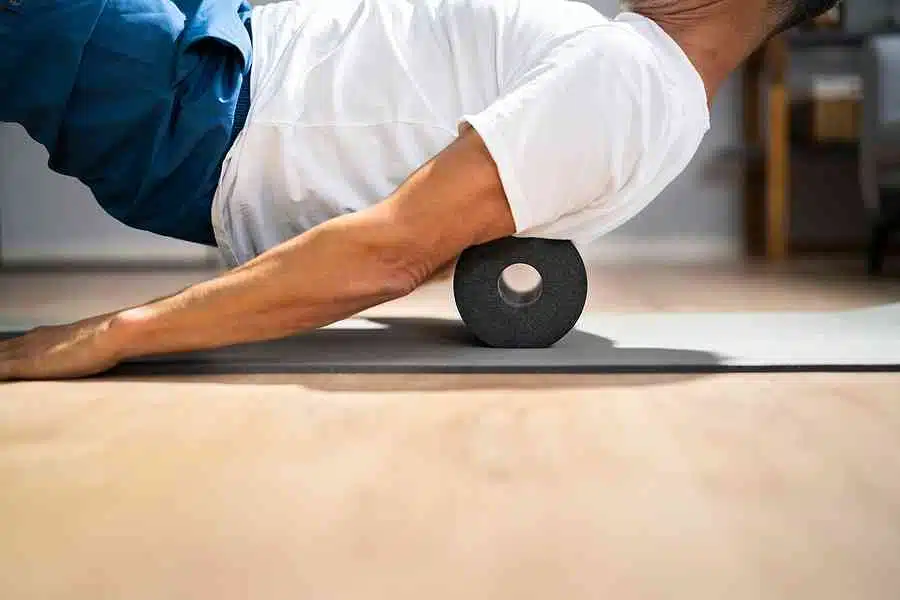Do Foam Rollers Work For Middle-Aged Back Pain

Back discomfort can be an unfortunate part of hitting middle age and is often due to our sedentary lifestyles, poor posture, or overuse injuries.
For the over-50s population, managing this pain often becomes a daily struggle.
However, one simple and versatile tool might just be the answer to this issue: the foam roller.
This piece of equipment offers a method of self-massage, known as foam rolling or self-myofascial release, which can significantly alleviate back pain and enhance mobility.
In this article, I’m looking into the world of foam rollers, exploring their benefits, types, and how they can effectively relieve back pain for those of us in middle age.
The Science Behind Foam Rolling
Foam rolling utilises the concept of self-myofascial release (SMR), a technique that involves applying pressure to tight or painful areas of the body to alleviate tension and increase range of motion.
The science and research on foam rolling are still growing, but it is generally believed that its benefits arise from this release of tension in the body’s muscles and fascia.
The Potential Benefits of Foam Rolling
There are numerous potential benefits to foam rolling, particularly for middle-aged individuals who may struggle with muscle tension and stiffness. Here are a few key benefits:
Supports Blood Circulation: Foam rolling may promote healthy circulation, similar to a good massage, which can be beneficial for sore muscles.
Boosts Flexibility: Foam rolling the muscles around stiff joints can help to ease tension and support your overall mobility.
Relieves General Aches and Pains: This includes post-workout muscle soreness, which foam rolling may alleviate.
Improves Athletic Performance: By enhancing muscle health and range of motion, foam rolling can potentially boost athletic performance.
Promotes Relaxation: Foam rolling sessions can be a time of mindful relaxation, helping to ease both mental and physical stress.
Various Types of Foam Rollers
Foam rollers come in various forms, each offering different benefits and experiences. Some of the common types include:
Soft Foam Rollers: These are excellent for beginners or those new to foam rolling, offering a gentler massage experience.
Firm Foam Rollers: These are ideal for athletes or those with extra-stiff muscles, providing a deeper, more intense massage.
Vibrating Foam Rollers: These rollers incorporate vibration therapy, which can work deeply into the muscle tissue.
Grid and Deep Tissue Foam Rollers: These rollers have textured surfaces, providing a more intense, focused massage experience. They are suitable for those with prior foam rolling experience.
Selecting the Right Foam Roller
Before investing in a foam roller, it’s important to consider your specific needs and preferences.
If you’re a beginner, a soft, large foam roller may be your best bet.
On the other hand, if you’re an athlete or active worker, you might prefer a textured, vibrating roller to work deeper into your muscle tissue.
The Dos and Don’ts of Foam Rolling
When using a foam roller for back pain relief, there are several guidelines to follow:
Dos:
Begin with gentle pressure and increase as required.
Maintain proper form for each exercise.
Use foam rolling as a recovery tool post-workouts.
Keep your sessions short, ideally between 5 to 20 minutes.
Pay attention to your body’s signals and adjust accordingly.
Don’ts:
Avoid massaging bones or areas without soft tissue.
Do not spend excessive time on trigger points.
Avoid foam rolling your lower back.
Do not use a foam roller on acute or aggravated injuries.
The Best Foam Rolling Exercises for Back Pain
Several effective foam rolling exercises can help alleviate back pain, such as the ‘Middle & Upper Back Roll’, ‘Hip Flexor Roll’, ‘Lats Foam Roll’, and ‘Chest Expansion’.
These exercises focus on various muscles and areas that often contribute to back pain, helping to release tension and improve flexibility.
The Potential Risks of Foam Rolling
While foam rolling is generally safe, it’s essential to be aware of potential risks.
These include avoiding massaging over fresh injuries, checking with a healthcare professional before starting if you’re pregnant, and talking to your doctor if you have any conditions that may not be compatible with foam rolling.
So foam rolling can be a highly effective tool for middle-aged individuals struggling with back pain.
By understanding the benefits, types, and techniques of foam rolling, you can significantly alleviate your discomfort and enhance your mobility.
However, as always, it’s important to consult with a healthcare professional before starting any new health regimen.





